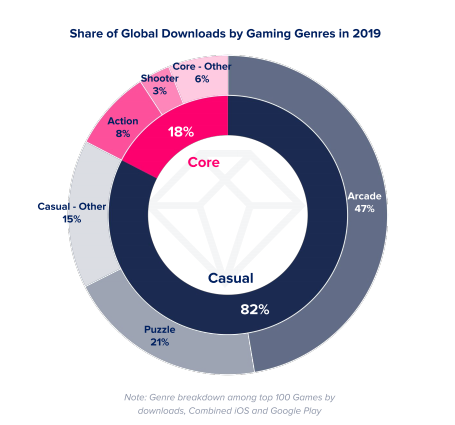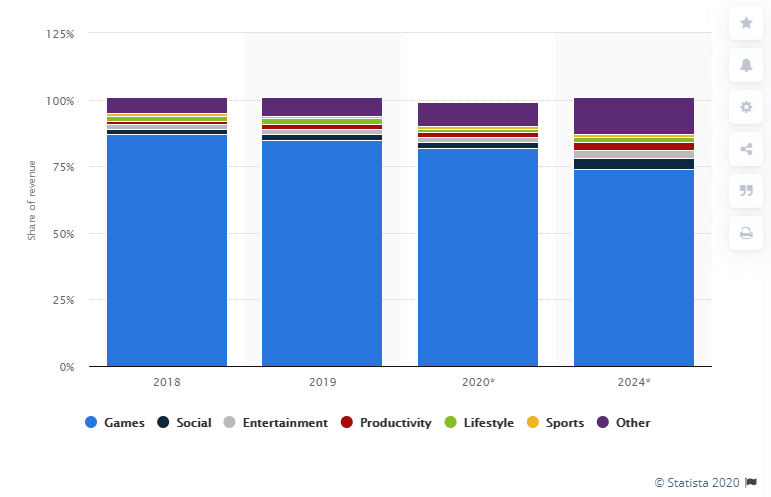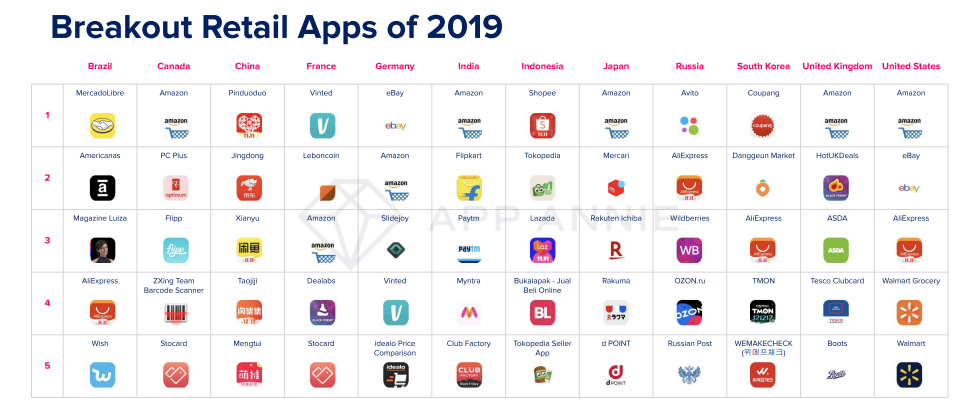More than ever companies have to grapple with operation efficiency, rapid market changes, and customer demands now. With global spending on enterprise software in 2020 equaling $426bn and mobile app revenue worldwide projected to reach $935.2bn in 2023, it’s important to stick to the pragmatic plan to take up the challenge. The latter includes the right mobile app development strategy, understanding key market drivers, opportunities, and restraints.
Highlights of Contents
What Makes an App Profitable?
The concept of a profitable app is not only that of a net profit but also serving customer needs best and bringing joy while using, which later boils down to what you call long-term users. Such apps become a part and parcel of people’s lives.
For example, news apps help to stay on top of the news, healthcare ones simplify the doctor-patient operations, sports apps encourage to keep a healthy lifestyle. A profitable app is also the one available in both Android and Apple stores.
Here are the key points shaping the successful mobile app:
- Getting the app in front of relevant users (understand the importance of keywords, get the right app description, choose the right app category, etc.),
- Localizing the app listing (adapting to the target audience and environment),
- Building up a community,
- Encouraging feedback,
- Increasing revenue (monetization, ASO, etc.).
List of Top 7 Most Profitable Mobile App Market Segments
By App Stores
1. Google Play Store
In 2020, with 74.24% of the mobile OS market share, Android keeps on holding the leading positions. A year ago, Google Play mobile app downloads amounted to $84.3bn.
Being one of the mobile app store pioneers, Google Play Store hosts an enormous amount of various content now boasting more than 3m apps as of September 2020.
The current number of free Android apps is 96.1% whereas 3.9% is left for the paid apps. The Play Store’s global app revenue jumped to $17.3bn in the first half of 2020.
2. Apple Store
“Find the app you love. And the ones you’re about to”. The App Store peaked at number two on the global market share. For iOS users, it’s the best place to search for fascinating new apps. In 2020, the number of apps in the App Store is close to 1.8m.
According to SensorTower, user spending on Google Play and App Store in Q1 2020 passed $50bn while two-thirds spent on the App Store.
Supposing that most of the total revenue qualifies for Apple’s commission, which represents approximately $10bn revenue for Q1 and Q2 of 2020 alone. That is no small charge, even for such a giant as Apple.
3. Other App Stores
Integrating users entirely under particular brands by providing their mobile app stores have become popular among device manufactures. Thus, the rest of the mobile app market includes Samsung Galaxy Apps, LG SmartWorld, Huawei App Store, Amazon App Store, Sony Apps, etc.
By Categories
4. Games
As of 2020, the most popular app category in the App Store is gaming apps: Candy Crush Saga, Clash Royale, and casino games. The best Android games are RPGs, shooters, puzzle games, and platformers. Among Us, Do Not Fall, etc. are among the top free games, and Minecraft, Empires & Puzzles, and Brawl Stars are the top-grossing ones.

The data collected by App Annie shows that mobile games hit 56% of the global market share while the total spending is projected to reach $100bn by 2020. Statista report indicates that gaming apps leave other categories far behind with about 85% total market share.

Developing a game isn’t cheap and is quite complicated in terms of further maintenance and support. However, once the company enters this highly competitive yet successful space, the revenue from mobile gaming apps may seem way higher compared to other categories.
5. Media and Entertainment
Globally users spend roughly 50% of their time in social media and entertainment apps. The latter became possible due to the growing adoption of video streaming, movie watching, TV shows, and live events.
TikTok and Twitch enter the top five of both Google Play and App Store rankings as of June 2020. YouTube (YouTube Music, YouTube Go), Netflix, Disney+, and Hulu follow right after.
As the first-movers to mobile, social and comms is a relatively mature industry. With “stories” features, AR, branded features, and more, social apps have become more than just entertainment apps resulting in FOMO. Breakout social apps include WhatsApp, Instagram, Facebook, and TikTok.
6. Education and Learning
According to AppBrain, education apps top the list of the most popular Google Play mobile app categories. Free mobile apps enabling learning from anywhere, containing high-quality content, and providing high usability make this world a better place.
To generate revenues from such apps, you can sell advanced training, books, premium video content, exclusive materials, etc. The most popular apps in this category are Duolingo, Babbel, ClassDojo, Coursera, YouTube, etc.
7. Retail and e-Commerce

Increased profit and time spent on e-commerce and business apps are driven by user bases growth and boosted engagement. With more businesses adopting mobile platforms, there’s a chance to enhance the mobile experience to streamline personalization and usability as well as better serve all phases of the buying journey ⎯ from browsing to tracking the purchase.
Others
Food and drink apps (Uber Eats, Postmates, GrubHub), dating apps (Tinder, JSwipe, Badoo), sports apps (ESPN, BBC Sport, Sports Navi), health and fitness apps (MyFitnessPal, 8Fit, Map My Fitness) get a minor yet deserving market share with a huge and dedicated audience.
The main privilege of other low-ranked mobile app categories such as news, utilities, navigation, and others is that of targeting a smaller market segment, thus making a profit anyway. For instance, utilities require little skill to be developed and a simple financial app could be sold for $0.99 each for thousands of hits.
By Region
- North America (US, Canada),
- Europe (UK, Germany, France, Italy, Poland),
- Asia-Pacific (India, China, Japan, South Korea),
- LAMEA (Latin America, Middle East, Africa).
App Revenue
The year 2020 is set to be mobile’s biggest year, with advertising fueling revenue. Having a variety of mobile app service monetization models, the most popular ones are paid apps with in-app purchases, free apps with in-app purchases, and in-app subscriptions. Impressively, the better part of mobile app development company revenue comes from in-game sales of virtual items.
By 2021, subscriptions for mobile apps related to dating, communication, streaming, and news will hit 25% at an annualized rate. As of June 2020, the gaming apps were the highest-grossing apps both in the Apple App Store and Google Play Store combined. Both Apple and Google are pushing forward subscription apps as they ensure more stable returns as opposed to in-app purchases.

It was a fabulous blog. Thank you for sharing. Such knowledge is really useful.
That blog is good. Do make such blogs and spread awareness.
Good Job! One of the most effective strategies.